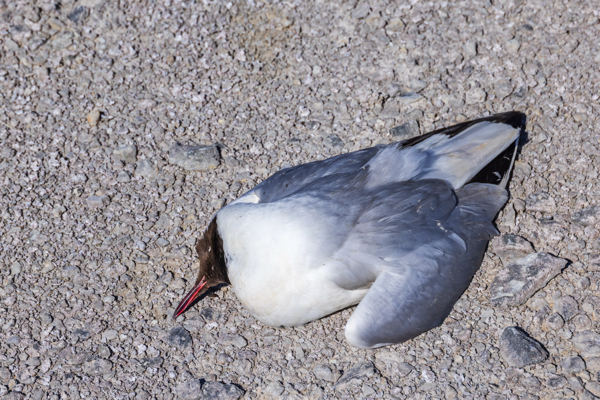Independent media spreads fearmongering rhetoric to pave way for "BIRD FLU plandemic"
By bellecarter // 2024-07-01
Tweet
Share
Copy

People are aware that mainstream media can be an arm for creating narratives that instill fear in the minds of the public. Some reports and investigations look into the Wuhan coronavirus (COVID-19) pandemic and they conclude that the outbreak may have been engineered. Sadly, even "independent" media is already taking part in the fearmongering efforts. Recently the media is focusing on the supposed worsening bird flu (H5N1).
Kit Knightly of Off-Guardian, cited how some "alternative news outlets" spread the narrative that health authorities are not that concerned about the spread of the H5N1 and that they are "not testing enough."
According to Salon, which published a 3000-word article about bird flu, experts have said that cases are likely flying under the radar. "So far this year, three Americans have been infected by H5N1 viruses that started in cows, and all of them recovered, but some experts say that patients may be avoiding doctors or refusing tests," it said, arguing that there is a lack of data and surveillance and that the government isn't doing "even close to enough" testing on animals and humans.
"Testing still seems somewhat random and voluntary. We should be doing more, both in cattle and humans," the write-up further noted.
Meanwhile, virologist Dr. Angela Rasmussen said testing requires collaboration between multiple state and local agencies, as well as the U.S. Department of Agriculture (USDA) and Centers for Disease Control and Prevention (CDC), which she alleged do not always cooperate. Dr. Keith Poulsen, an associate professor of large internal medicine at the University of Wisconsin-Madison also accused that there are too many "legal and political barriers" to testing for avian flu.
The Salon article also accidentally revealed some major talking points such as that at-home flu tests will likely pick up H5N1 because it's closely related to influenza A. "The big challenge is we will not be able to differentiate between [seasonal] flu and H5 unless we have a more specific test," Katelyn Jetelina, an epidemiologist and author of the newsletter "Your Local Epidemiologist," said. This just means that when flu season starts in the fall, reported "bird flu" cases may rise sharply.
Experts featured in the article also implied that the more tests are given, the more cases will be listed; animal testing is not subject to lab standards and many of those "missed" human cases will be "asymptomatic infections."
Knightly further cited the Guardian and the World Socialist Website, which continue their COVID-19-era policy of abandoning any pretense of being an "independent" media outlet and repeating or even exaggerating mainstream claims to further their political agenda. (Related: FEAR PSYOP: High mortality bird flu could already be engineered for rapid human transmission, warns former CDC head Dr. Robert Redfield.)
Climate change expedites the spread of the bird flu virus
Both mainstream and independent media also now proliferate the idea that climate change is helping the H5N1 virus to spread and evolve. According to the Conversation, since the virus has already been found on all continents, it is already considered "a global zoonotic animal pandemic" because of its widespread infection in wild birds, poultry and dairy herds. H5N1 is known to be able to infect over 350 species of birds and close to 60 species of mammals. However, there are very few reported human cases of infection. The CDC even admits on its website that the current public health risk is low. The total number of reported human cases in the United States is just four since 2022. There were three exposures to dairy cows reported between April 1 to May 29 while one exposure to poultry was reported on April 28, 2022. Three states in the U.S. have reported cases. But to make the narrative even more "alarming," a new rhetoric is being promoted. The article indicated that climate change seems to be impacting the emergence of zoonotic viruses like H5N1 and as global climate conditions change, avian migratory patterns and routes are also changing. "Higher temperatures and extreme weather have resulted in large-scale population shifts in a range of temperate species. These changes have led to diseases emerging in areas and in genetic configurations entirely unique and unprecedented," the article claimed. "H5N1 is a clear indication that disease monitoring and response efforts are an essential part of any climate change adaptation and mitigation strategy." It also presented that wider seasonal variation is enabling the emergence of novel H5N1 variants, citing that in North America, the warmer winters and earlier onset of spring which global warming is causing could allow some moisture-reliant pathogens to survive and spread more easily. "Cooler and wetter conditions can enhance the survival of influenza viruses in bird droppings and contaminated water," it asserted. "Simply put, the spread of influenza viruses around the globe is dictated by their ability to survive long enough in a place to be able to transmit elsewhere and climate change is, in some cases, making this survival more likely." It also maintained that the recent cases of poultry-to-human and cattle-to-human transmissions underscore the threats posed by these viruses and the importance of understanding how climate change is affecting their spread. Check out Influenza.news for more stories about bird flu.Sources for this article include:
Off-Guardian.org Salon.com TheConversation.com CDC.govTweet
Share
Copy
Tagged Under:
collapse mainstream media climate change propaganda conspiracy fake news big government deception lies deep state pandemic insanity outbreak bird flu cattle narrative plague avian flu H5N1 disinfo climate alarmism badscience badhealth fearmongering rhetoric covid-19 independent news outlets
You Might Also Like
Poland preparing military for World War III, NATO reveals
By Ethan Huff // Share
Scary new study reveals PFAS “forever chemicals” can seep through human skin
By Cassie B. // Share
Recent News
Iran conducts surprise missile drills amid rising tensions with Israel
By kevinhughes // Share
Kremlin denies reports of plans to "restore Soviet influence"
By bellecarter // Share
How AI news bots are quietly reshaping public opinion
By avagrace // Share
The Unshackled Physician: A surgeon's awakening to medical tyranny
By ramontomeydw // Share











